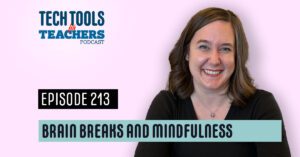Shanna Martin 0:19
Thanks for listening to the Tech Tools for Teachers Podcast, where each week we talk about a free piece of technology that you can use in your classroom. I’m your host, Shanna Martin. I’m a middle school teacher, technology and instructional coach for my district.
Fuzz Martin 0:31
And I’m her producer and husband, Fuzz Martin just over here composing this podcast each and every week.
Shanna Martin 0:37
Oh, that was clever. Thanks. Because we’re talking about is a music pop about? Yeah, you got a button for that?
Fuzz Martin 0:47
I do somewhere.
Shanna Martin 0:48
I didn’t really have a prepared though. That’s okay. So we’ll have lots of other sound effects. Yeah,
Fuzz Martin 0:54
we sure Well,
Shanna Martin 0:55
there’s enough sound effects last week. Yay. So moving on the school year, I feel like we’re already cranking through like it’s October and holy cow September’s over. It is. So we’ve been talking about AI things last couple of weeks. And I and a have more hand I have more to that. That’ll be the that was like part one part one and a half, part two will be coming up two weeks down the road. But I visited Google, Google Chrome experiments a week or two ago. And I realized how many cool new things are there. So I decided that this week, oh, we need to have some fun now that we don’t have fun every week. But we’re gonna have some fun with some Chrome experiments as we go. I’m very excited because they’re adorable. And not all adorable, but just fun. Remember, Chrome experiments, we’ve talked about them before, in a few different episodes. And they’re these cool things that, you know, people are testing out their coding skills and their technology skills. And they’re just cool, fun things to have kids engage with in your classroom. So like, Well, this week, there are a couple of music focused ones and some like sensory like moments of calm kind of stuff. You can build these in any classroom, at any point in time, you need five minutes of your sanity. And the kids just need something to do that’s just kind of fun. Throw in your headphones, kids, right? Just try this out. So cool. And I do that. I mean, I teach social studies, and I’m doing technology, and I’m all over the place all the time running through my building, and like, hey, just try this with your kids. And they’re like, What, and then they’re just excited for like, five minutes of their life or 10 minutes of life, and then they play around with it later on. And those that are really into it, continue it. So Chrome experiments, we’re talking this week, there’s some music and like, calmness, and just some really fun things to play around with. I’m excited. I know, I told you what we were doing. And all of a sudden, all these noises were coming from your computer. So the first Chrome experiment you’re going to talk about we go to Experiments with Google, the easiest way to find your Chrome Experiments is to type in Chrome Experiments. And then you’ll get there I have linked them all into yeah, there’s no website URL to get to the there’s not because like experiments dot with google.com / then you gotta find all the stuff and it just it’s the links will be at smartinwi.com. Yep. And if you type in, the first one is called Beethoven Beats.
Fuzz Martin 3:32
If you typed in Beethoven Beats, you’d find it you will find it.
Shanna Martin 3:34
Yeah. So that’s the best. There’s no real clean way to pull these up. But once you have them linked, they’re easy to get to. Yep. What’s cool is you can go and it gives you a little background. So it’ll tell you who the designer is, it will tell you what you’re going to learn from it. So Beethoven Beats is based on Beethoven’s music. And because of all of the rhythmic patterns that come that are written in his symphonies, and his music, there’s so many cool compositions that pull this information from. So basically, when you go to launch the experiment, like launch experiment, you’re gonna tap out rhythms to Beethoven Beats. Okay. You can try this while I talk you through it. Sure. It gives you a little intro. So like they talked about like raindrops on your window, whether you’re like beats, so you’re gonna tap out your beats with your spacebar and then tap to create a rhythm. And you have four seconds to record. So you go ahead and tap out your rhythm done. And then once you’ve tapped out your rhythm, you then cure whichever piece of Beethoven music fits that rhythm.
Fuzz Martin 4:43
Yeah, you know, and so you would say, Tap, Tap, Tap, Tap, Tap, Tap, Tap, Tap, Tap, Tap, Tap, Tap. That’s cool.
Shanna Martin 4:55
And then what’s cool, which piece of music did you pull up?
Fuzz Martin 4:59
Oh, I I clicked it already off there. So we’ll go, we’ll go again.
Shanna Martin 5:04
So as if you’re a music teacher, or you want to engage some kids,
Fuzz Martin 5:09
This one is Sonata number 31, in a flat, A flat major.
Shanna Martin 5:14
So you can talk about majors and minors, but then click Explore this synapse for that Sonata. Whoa. And then it’s the whole piece of music. Yeah. And you can listen to it. And you can see the rhythms within it, because you can see all the little dots across the bottom. And then it gives you the history of it, which I think is really cool. It gives you like, about the work and when it was written, and all of the different pieces of information.
Fuzz Martin 5:40
Yeah, this one was composed in 1821. You’re listening to Sonata number 31.
Shanna Martin 5:46
Thank you for sharing with Beethoven Beats. So it’s really cool. So while it engages kids and just some rhythm, it also then we’ll teach them about Beethoven and about his piece of music. And then you can play the full piece of music afterwards. And it’s just a quick, fun way to engage kids. And I think it gives them in some classical music, as well as learning some musical skills behind it. Yeah. And once you go to close out of it, what’s cool then is you keep playing with it and keep playing with it. I will close out of it, it will say then games you might like. So we’ll give you other Google Chrome experiments that you might engage with. That would be fun. So like one of our favorites and favorite non favorite, I can’t tell you it’s blob opera is opera. It was episode 88. For me, I talked about Blob Opera. And I can’t tell you how many, like people reached out like, oh my gosh, we love this experiment. And they listened to that podcast episode, which is awesome. So thanks for listening back to my podcasts from a long time ago. But Blob Opera fan favorite they have Blob Beats now. Yeah. Which is like another like fun. gamey version of Blob Opera. There’s plenty to play with. Are you playing it? You look like you’re like gonna jump
Fuzz Martin 7:00
I started, but I didn’t know what it was going to do. So okay,
Shanna Martin 7:03
so we’ll say that, hey, try it out. And then you asked me for Blob beats blob beats Blob Opera again. So you can engage kids in music very easily without a ton of background, but it would start to spark great conversations with kids about music, and rhythm and classical composers. And it’s just very cool. So Beethoven Beats is my first Google Chrome Experiment to test out my second one I’m even more excited about because it’s so cute. So if you love blob opera, folks, you need to meet Viola the bird. Okay, so you go to Viola the Bird again, experiment Viola the Bird. She is a cello experience. The new hired instruments. Music meets tech. Okay, we’re gonna launch Viola who is so stinking cute. She is. She’s so cute. Like, it’s an ostrich.
Fuzz Martin 8:12
It’s an ostrich,
Shanna Martin 8:13
she’s she’s purple.
Fuzz Martin 8:14
She’s purple. Like she’s got like the breathing kind of, like blinking motion effect the animation effects that she like, feels alive. Yes. And she’s holding a bow in her mouth.
Shanna Martin 8:25
And she plays classical music so you have the option of choosing concert. And if you have cancer in the bottom right hand corner of the screen, then you can flip through other pieces of music. So you there’s Ode to Joy. There’s Canon and D. There’s the Theme from Jupiter. Ave Maria, Londonderry anyway, so there’s lots of songs that you can pick from. And as fast as playing with Viola right now, you drag your finger across your thank you mouse pad. And Viola plays the classical music so it teaches you the rhythm and teaches you about the song. What’s also cute as you can record the left hand button on the bottom screen, you can record Viola playing your song. And then you also have the freestyle option, which is like I’m teaching right now and we’re focusing the freestyle option puts her in with her very own looks like homemade version.
Shanna Martin 9:36
She is under a waterfall and you can play your own song with her and then record it, which is really cute. So once you record as far as the so kindly playing in the background, it’s just a little mood mood music. Yes, thank you not distracting at all. So when you’re done playing and recording with Biola You can share your creations, so very similar to blob opera. I feel like I’m in my classroom. And so then you can share it was super cool. And they’ve changed like with this experiment. Yeah. When kids share, they can email to you, but they have a link directly to Google Classroom. So you can drop Viola right into Google Classroom and turn it in. And or share it. Oh, that’s cool. So it’s meant like, Viola is definitely student friendly. And so the kids can play or show you some musical skills. And then they can share it with anybody, including their parents are including you, and they can drop in Google Classroom, which I love. Well, bylaws adorable. So I told you just just go play with file for a bit. Because it’s so cute.
Fuzz Martin 10:52
Just a concert for the listeners.
Shanna Martin 10:55
Yes. That’s really what they want to hear.
Fuzz Martin 10:59
They tune in for Yeah. Is you playing as in Viola, Viola,
Shanna Martin 11:05
the purple ostrich. So anyway, it’s such a fun Chrome Experiment. So
Fuzz Martin 11:09
violet ostriches.
Shanna Martin 11:10
She’s the violet ostrich, okay. So again, classical music, super engaging, very easy to roll out to your kids. And then they can record their songs. And highly entertaining, whether it’s music class, or if it’s brain break time, or if it’s, you know, some site if they get some creative time, and they’re they it’s just so fun. So fun. Yeah, it’d be like Blob Opera, you’ll definitely love Viola, she’s adorable. With all of that, we have our two music. So we’ve got Beethoven, we have Viola, the last one I wanted to share is called In Rhythm with Nature. Now this is not a music creation piece like the other two are, this is more of bringing calm and kind of center to your day. So if you are looking, or you just keep playing the soundstage, if you are looking to like, bring your kids down a second, and maybe we just need a moment of calm in the classroom, or as a teacher, maybe when you get the five minutes, you get to eat lunch, you need some calm in your life. That’s what this one is for. So you gotta launch the experiment. And it’s in rhythm with nature. And as you pointed out, which I appreciated, it’s meant to put a moment of calm in your day, I
Fuzz Martin 12:24
was like this thing is taking forever to load. And I
Shanna Martin 12:26
said, that’s because it’s purposeful, and taking forever to load. That’s the point. I’m, so you got to enter, there’s like a clock time to slow down with nature. It loads slowly with flowers, because it’s meant to calm you down and slow you down a bit. Then it has different images of flowers on the screen. And you can choose the different flowers have a different like song that kind of go with them or some background music. Okay, so each flower has its own like peace. A goal is just to have you breathe, and like take a minute sit back, relax, it’ll tell you what flower you’re just taking a break with. They’re pretty there’s little butterflies fly around on the screen. It’s a sense of like meditation, basically. And then what’s kind of neat is if you click on, there’s like a little meditating person on the bottom, when you click on that, the flowers will bloom and lows as you should be breathing. Okay, so to like focus your breathing, which we all try to do to like calm down, and it doesn’t really work. It’s a visual. So I’ll tell you like breathe in, breathe out, and the flowers open and close. So you can calm down. And then if you want to change your flower, which will change your sound, then you just pick a flower to the right or to the left. And again, it’s like a clock. So there’s like 12 different flowers you can pick from. And again, the whole goal is to take some time. Take a minute to calm down to breathe. And then just process. Yes, thank you. I appreciate you meditating. For me. Yes, we will. We are there. So from Viola to meditation. That is where we’re at today. So that’s a cool experiment, especially to teach your kids to bring a moment of calm in their day. And then as teachers, sometimes you need a moment of calm in your day. Yeah, it’s deliberately slower. So you do take a minute to process. So there’s another super fun Chrome Experiment.
Fuzz Martin 14:39
Yes, me too. I love these Chrome Experiments. That one’s In Rhythm with Nature. So I want to feels like Headspace. Do we do an episode on Headspace one time?
Shanna Martin 14:47
We did? Yeah, a while back. So yeah, it’s an awesome, awesome Chrome experiment. So we have three of them to share with you. I mean, there’s tons and tons more I’m guessing I’ll probably throw a few more at you throughout the season because there’s so many fun one And so check out Beethoven. Check out Viola, the bird and check out in rhythm with nature. And I think that you’ll find some cool things to throw at your students. And definitely any of these can be used. K 12. And the kids will be able to handle them themselves on their Chromebooks or you can put them on your smart board. And
Fuzz Martin 15:18
by the way, Episode 102 was the Headspace. Headspace. All right.
Shanna Martin 15:24
Awesome. Well, thanks for tuning in. This has been the Tech Tools for Teachers Podcast. If you ever have any questions, you can find me on that app formerly known as Twitter at smartinwi or on Threads, or on Facebook. Oh, and they’re super cute little coffee mugs. Now, if you go to smartinwi.com There is the cutest coffee mugs.
Fuzz Martin 15:45
Yeah, if you go to shop the page you’ll see the cute little coffee mugs, put one in your classroom, put it on your desk,
Shanna Martin 15:52
share it with a friend it says
Fuzz Martin 15:55
teach. Sip, repeat, repeat.
Shanna Martin 15:58
And if you want get more information on the links to the technology discussed in this episode, you can visit smartwi.com. If you’d like to support the show, please consider buying me a coffee or to visit buymeacoffee.com/smartinwi or visit smartinwiwi.com and click on that cute little purple coffee cup, which is a digital one to donate the actual one that was talked about ordering. Your donations help keep the show going new episodes each week. Thanks for listening, go educate and innovate.
Fuzz Martin 16:29
The ideas and opinions expressed in this podcast and the smartinwi.com website are those of the author Shanna Martin and not her employer. Prior to using any of the technologies discussed on this podcast, please consult with your employer regulations. This podcast offers no guarantee that these tools will work for you as described, but we sure hope they do. By the way, my favorite piece of merch that you have on your website, Shanna is still the one that says Until We Google Meet Again.
















